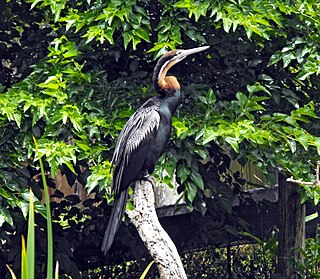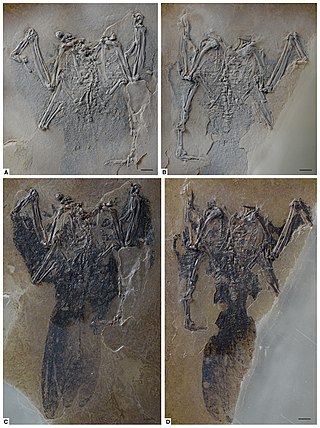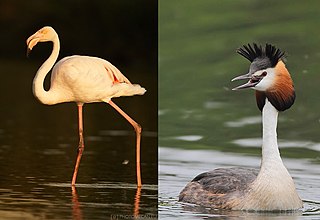
Flamingos or flamingoes are a type of wading bird in the family Phoenicopteridae, which is the only extant family in the order Phoenicopteriformes. There are four flamingo species distributed throughout the Americas, and two species native to Afro-Eurasia.

The darters, anhingas, or snakebirds are mainly tropical waterbirds in the family Anhingidae, which contains a single genus, Anhinga. There are four living species, three of which are very common and widespread while the fourth is rarer and classified as near-threatened by the IUCN. The term snakebird is usually used without any additions to signify whichever of the completely allopatric species occurs in any one region. It refers to their long thin neck, which has a snake-like appearance when they swim with their bodies submerged, or when mated pairs twist it during their bonding displays. "Darter" is used with a geographical term when referring to particular species. It alludes to their manner of procuring food, as they impale fishes with their thin, pointed beak. The American darter is more commonly known as the anhinga. It is sometimes called "water turkey" in the southern United States; though the anhinga is quite unrelated to the wild turkey, they are both large, blackish birds with long tails that are sometimes hunted for food.

The mousebirds are birds in the order Coliiformes. They are the sister group to the clade Cavitaves, which includes the Leptosomiformes, Trogoniformes (trogons), Bucerotiformes, Piciformes and Coraciformes. This group is now confined to sub-Saharan Africa, and it is the only bird order confined entirely to that continent, with the possible exception of turacos which are considered by some as the distinct order Musophagiformes, and the cuckoo roller, which is the only member of the order Leptosomiformes, and which is found in Madagascar but not mainland Africa. Mousebirds had a wider range in the Paleogene, with a widespread distribution in Europe and North America during the Paleocene.

Palaelodus is an extinct genus of bird of the Palaelodidae family, distantly related to flamingos. They were slender birds with long, thin legs and a long neck resembling their modern relatives, but likely lived very different livestyles. They had straight, conical beaks not suited for filter feeding and legs showing some similarities to grebes. Their precise lifestyle is disputed, with researchers in the past suggesting they may have been divers, while more recent research suggests they may have used their stiff toes as paddles for swimming while feeding on insect larvae and snails. This behavior may have been key in later phoenicopteriforms developing filterfeeding bills. The genus includes between five and eight species and is found across Europe, Australia, New Zealand, Asia and possibly South America. However some argue that most of the taxa named from Europe simply represent differently sized individuals of one single species. Palaelodus was most abundant during the Late Oligocene to Middle Miocene periods, but isolated remains from Australia indicate that the genus, or at least a relative, survived until the Pleistocene.
Megapaloelodus is an extinct genus of stem flamingo of the family Palaelodidae. Megapaloelodus is primarily known from Miocene America, from South Dakota and Oregon in the north to Argentina in the south, but the species Megapaloelodus goliath was found in Europe. Additionally, one unnamed species was discovered in Miocene sediments from Namibia. Due to a lack of skull material, little can be said about the ecology of Megapaloelodus. Species of this genus are typically larger than those of Palaelodus and appear to have inhabited similar brackish lake environments. Additionally, they may have been capable of "locking" their legs in a standing position.

The Pelagornithidae, commonly called pelagornithids, pseudodontorns, bony-toothed birds, false-toothed birds or pseudotooth birds, are a prehistoric family of large seabirds. Their fossil remains have been found all over the world in rocks dating between the Early Paleocene and the Pliocene-Pleistocene boundary.
Torotix is a Late Cretaceous genus of aquatic birds. They lived along the shores of the Western Interior Seaway, but it is not clear whether they were seabirds or freshwater birds, as the genus is only known from a humerus. Consequently, the genus contains only one known species, Torotix clemensi. T. clemensi is represented by a single fossil specimen, a partial humerus recovered from the Lance formation of Wyoming. Its deposits are dated to the very end of the Cretaceous period, 66 million years ago.

Archaeotrogonidae is a prehistoric bird family known from the Eocene and Oligocene of Europe. They are members of Strisores, and are thought to be closely related to nightjars.

Mirandornithes is a clade that consists of flamingos and grebes. Many scholars use the term Phoenicopterimorphae for the superorder containing flamingoes and grebes.

Odontopteryx is a genus of the extinct pseudotooth birds or pelagornithids. These were probably rather close relatives of either pelicans and storks, or of waterfowl, and are here placed in the order Odontopterygiformes to account for this uncertainty.
Cyphornis is a genus of the prehistoric pseudotooth birds. These were probably rather close relatives of either pelicans and storks, or of waterfowl, and are here placed in the order Odontopterygiformes to account for this uncertainty.

Dasornis is a genus of prehistoric pseudotooth birds. These were probably close relatives of either pelicans and storks or waterfowl; they are placed in the order Odontopterygiformes to account for this uncertainty.
Palaeochenoides is a genus of the prehistoric pseudotooth birds of somewhat doubtful validity. These were probably rather close relatives of either pelicans and storks, or of waterfowl, and are here placed in the order Odontopterygiformes to account for this uncertainty.

Pelagornis is an extinct genus of prehistoric pseudotooth birds, a group of extinct seabirds. Species span from the Oligocene to the Early Pleistocene. Members of Pelagorinis represent among the largest pseudotooth birds, with one species. P. sandersi, having the widest wingspan of any bird known.

Palaelodidae is a family of extinct birds in the group Phoenicopteriformes, which today is represented only by the flamingos. They were widespread during the Neogene, with fossil remains found on all continents other than Antarctica. The oldest remains referred to this group appeared in the fossil record during the Oligocene in Egypt and Belgium, before palaelodids reached their peak diversity during the Miocene. Following this the group declined in the early Pliocene before going extinct on most continents. However, remains found near Cooper Creek in the Lake Eyre Basin indicate that palaelodids managed to survive in Australia until the Pleistocene. Currently three genera are recognized by scientists: Adelalopus, Palaelodus and Megapaloelodus. Most fossil remains stem from Europe and have been assigned to the type species, Palaelodus ambiguus. Due to the fragmentary nature of most of these species, little is known about their ecology. They appear to have preferred brackish lakes and lagoons. Palaelodus has previously been thought to be a wader or diver, but recent research indicates that they were better suited for swimming and possibly fed on insect larvae and other aquatic invertebrates. At least Megapaloelodus appears to have adaptations for "locking" their legs in a standing position.

Juncitarsus is an extinct genus of wading birds from the Eocene of the United States and Germany. Though previously considered a flamingo, it is likely a stem-flamingo, possibly a relative of the group which contains both flamingos and grebes (Mirandornithes).

Ardei is a possibly-paraphyletic suborder of order Pelecaniformes that include the families Ardeidae and Threskiornithidae. Traditionally the ardeids and threskiornithids were classified in the order Ciconiiformes along with Ciconiidae (storks), Phoenicopteridae (flamingos), Scopidae (hamerkop), Balaenicipitidae (shoebill), and even Cathartidae. However, there were some osteological studies that have questioned the monophyly of Ciconiiformes, suggesting that the ardeids and threskiornithids originated from early gruiforms, with the latter being a transitionary taxon to order Charadriiformes. The non-monophyletic nature of Ciconiiformes is supported by recent genomic studies that have found support for threskiornithids, ardeids, scopids and balaenicipitids being closely related to Pelecanidae (pelicans).
Harrisonavis is an extinct genus of flamingo that lived during the Late Oligocene and Early Miocene periods in what is now France. Despite being one of the oldest known members of the flamingo family, it already shows a skull remarkably similar to that of the modern greater flamingo. Although generally similar, it subtly differs in the curvature of the bill and the size of the ventral keel of the maxilla, both signs that Harrisonavis was not yet as adapted towards filter feeding as modern species are. Harrisonavis inhabited brackish lakes alongside the more basal Palaelodidae. It contains the single species Harrisonavis croizeti, first described in 1852.
Agnopterus is an extinct genus of stem-flamingo phoenicopteriform with fossil material from France, as well as possibly England, Kazakhstan, and Brazil. The holotype specimen for type species A. laurillardi is an incomplete distal tibiotarsus from Late Eocene gypsum from Paris; a coracoid, humeri, a scapula and perhaps a proximal femur have been recovered from Late Eocene to Early Oligocene of England to a possible second species, A. hantoniensis. Two additional species from the Late Oligocene-Early Miocene have been named as well. A. turgaiensis of Kazakhstan and A. sicki of Brazil. While all four species are considered to be close to the ancestry of flamingos, their exact relationships and placement as members of Agnopterus is uncertain.













